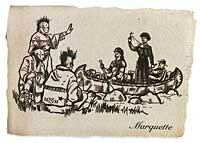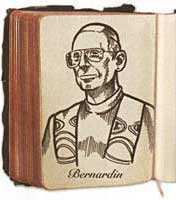 Enter the Missionaries (1673-1700)
Enter the Missionaries (1673-1700)
Chicago’s recorded history opens with the entrance of a Catholic priest. In September 1673, Père Jacques Marquette, a French-born Jesuit, arrived by canoe at Lake Michigan and the mouth of the Chicago River in the company of Louis Jolliet, a Jesuit-educated French Canadian. It was the beginning of a trend. “All the early white visitors to the site of Chicago were of the Catholic faith,” writes the Jesuit historian Gilbert J. Garraghan, “and with their coming were forged . . . the first links of association between the Catholic church and the future city.”
The missionary and the explorer did not linger in Chicago, but Marquette returned the following December. Ill with dysentery and fever, the southbound Jesuit could travel no farther. His two companions built a log hut somewhere along the Chicago River-the first structure built here by white people-and there the trio wintered (a peculiar monument in the 2600 block of South Damen Avenue stands near the likely spot). During his stay, Marquette regularly said Mass (the city’s first) and kept a journal that survives today-the inaugural contribution to Chicago’s literary tradition. Later, the priests who came through “Chicagou” provided additional accounts of the place, including an April 23, 1699, letter-“probably the oldest written communication dated from Chicago,” claims Garraghan-penned by the Seminarian missionary François de Montigny.
In 1696, the Jesuits established the Mission of the Guardian Angel in Chicago, probably somewhere in the vicinity of the Wrigley Building; led by Père François Pinet, it ministered to the Miami Indians who lived nearby. Following infighting among religious orders, intrigues in Quebec, and shortsightedness at the court of Louis XIV, La Mission de l’Ange Gardien closed around 1700, bringing down the curtain on the first act of Chicago’s story.
 The Priest, the Builder, and the Bishops (1700-1871)
The Priest, the Builder, and the Bishops (1700-1871)
After the closure of its Jesuit mission, Chicago was ministered to from afar, nominally served by the dioceses at Quebec, Baltimore (beginning in 1784), and Bardstown, Kentucky (1808). In 1833, when Chicago incorporated as a village, more than a third of its 350 residents were Roman Catholics, and they requested a full-time priest. On May 1, 1833, Father John Mary Irenaeus St. Cyr arrived in Chicago, where he would remain, with some brief absences, until 1837.
St. Cyr encouraged construction of St. Mary of the Assumption, the city’s first Catholic church (near the southwest corner of State and Lake streets). Built by Augustine Deodat Taylor, this unassuming structure signaled the beginning of an architectural revolution: its balloon-frame construction-supplanting the old mortise-and-tenon method-dramatically reduced the amount of time and labor needed to erect a building. The church survived until 1871, when it was destroyed by the Great Chicago Fire.
In 1843, Pope Gregory XVI created the Diocese of Chicago, and the city’s first bishop, William J. Quarter, arrived in 1844. Before his sudden death in 1848, this zealous prelate created the city’s first cathedral, its first Catholic grade school and high school, and its first Catholic university, St. Mary of the Lake, which occupied the block bounded by what are now State and Superior streets and Wabash and Chicago avenues. (The great, ac-tive cathedral currently on that site took its name from the university’s Holy Name Chapel.)
Four bishops succeeded Quarter, culminating, in 1870, with Thomas Foley, Chicago’s first American-born bishop. The diocese had 24 parishes, 22 parish schools, and several other Catholic institutions. All that changed in October 1871 when fire ravaged the city, inflicting $1 million in damage to church property. “[My] church looks like a spectre in that dreary waste,” said one pastor. “All is gone.”
 A Common Altar: Chicago’s Immigrant Catholics (1846-1925)
A Common Altar: Chicago’s Immigrant Catholics (1846-1925)
From 1834 to 1843, Chicago belonged to the diocese based at Vincennes, Indiana, and in 1835, its bishop, Simon William Gabriel Bruté, visited the small town at the foot of Lake Michigan. “Here the Catholics have a neat little church,” he wrote (referring to St. Mary’s). “Americans, Irish, French and Germans meet at a common altar, assembled from the most distant parts of this vast republic or . . . from the shores of Europe to those of our lakes.”
In the mid-19th century, Chicago’s growing immigrant populations began to demand their own churches, with services and sermons in their native tongue. In 1846, the Irish got a church-St. Patrick’s-and the Germans got two: St. Peter’s, south of the river, and St. Joseph’s, on the North Side. (That same year saw the arrival of the Sisters of Mercy, the city’s first religious order of women.) The first Bohemian (St. Wenceslaus, 1863) and Polish (St. Stanislaus Kostka, 1867) churches opened in the 1860s. At Bishop Foley’s death in 1879, there were 38 different ethnic churches in the diocese.
Foley’s successor, Patrick Feehan, the city’s first archbishop-Pope Leo XIII established Chicago as an archdiocese in 1880-added another 94 “national” parishes, including the city’s first Italian church, Assumption BVM (1881). In 1889, John Augustine Tolton, a former slave and the first African American priest ordained in the United States, arrived in Chicago, and the city’s black Catholics got their own church, St. Monica’s, in 1894. The first Mexican church, Our Lady of Guadalupe, opened in 1925.
Even today, ethnic churches continue to play an essential role in the lives of the foreign-born Catholics who pour into Chicago. “So long as immigrants find the city attractive,” writes the local historian Edward R. Kantowicz, “there will be a need for way stations on the journey between one country and another-and between this world and the next.”
 A Prince of the Church (1903-1939)
A Prince of the Church (1903-1939)
In 1903, Chicago welcomed its second archbishop, James Edward Quigley. In addition to creating scores of new churches, Quigley boosted Catholic education, establishing a coeducational parochial school at Holy Name, encouraging the development of Loyola and DePaul universities, and organizing a high-school seminary. During his tenure, in one of the city’s more peculiar rehabs, Holy Name Cathedral, built in 1874, was literally cut in half; builders moved the eastern portion back some 15 feet to a new foundation and filled in the resulting space to provide a larger interior.
Given Chicago’s prominence in the U.S. church, credible rumors spread that Quigley would be elevated to the College of Cardinals. But in 1915, the archbishop suddenly fell ill, and he died that year at the age of 60. His successor, George Mun-delein, was at 43 the nation’s youngest archbishop. A talented administrator who reveled in the trappings of his office, Mundelein showed a knack for finance, forming close connection with leading businessmen in Chicago and New York. (Someone once characterized Mundelein as either “the most successful banker to ever run a diocese or . . . the most successful priest ever to build a bank.”) He erected a Gothic Gold Coast home for his predecessor’s high-school seminary-which he christened Quigley Preparatory-and envisioned a great Midwestern Catholic university north of the city (in the town now known as Mun-delein). Though that plan fell through, he did build there the lavish St. Mary of the Lake Mundelein Seminary.
Anointed cardinal in 1924, Mundelein emerged as the nation’s most powerful Catholic. He was a friend of the Chicago machine boss Ed Kelly, and on a first-name basis with Franklin Roosevelt. Though of German ancestry, Mundelein was a vocal critic of Adolf Hitler; he provided strong support for the president’s New Deal policies, and served as his unofficial emissary to the Vatican. At some time during the night of October 1-2, 1939, Mundelein died in his residence at St. Mary seminary following a clandestine conference with Tommy Corcoran, a top FDR aide.
 Cardinal Virtues-and Vices (1940-1996)
Cardinal Virtues-and Vices (1940-1996)
Since its creation in 1843, the Diocese of Chicago, which originally encompassed all of Illinois, had shrunk geographically, until, in 1948 (with the creation of the Diocese of Joliet), it included only Lake and Cook counties. Yet at Mundelein’s death, Chicago reigned as the country’s most populous diocese, and the elevation of its archbishop to the rank of cardinal became a pro forma event. Samuel Alphonsus Stritch, the archbishop of Milwaukee, succeeded Mundelein in 1940, and received his scarlet miter six years later. Stritch confronted a diocese in transition. City dwellers were heading for the suburbs, while some African American Catholics began moving into neighborhoods once dominated by the all-white urban parishes. Formed in 1946, Chicago’s Catholic Interracial Council began to address the upheaval spawned by those changing demographics.
Following Stritch’s death (in Rome, in May 1958), his successor, Albert Gregory Meyer, tackled the civil rights problem head on. In 1963, his efforts came to fruition with the Chicago Conference on Religion and Race, which attracted over 700 clergy members from more than 60 denominations around the country. Created cardinal in 1959, Meyer also emerged as the intellectual leader of the U.S. bishops at the Second Vatican Council, convened by Pope John XXIII.
John Patrick Cody succeeded Meyer in 1965. An able administrator who championed racial justice and harmony, Cody displayed an autocratic style that angered his younger subordinates, who formed a united opposition in 1966 as the Association of Chicago Priests. Pope John Paul II’s visit in 1979 was a triumph for the city, but scandal clouded Cody’s final years: in 1981, a federal grand jury investigated allegations by the Chicago Sun-Times that Cody had diverted as much as $1 million to Helen Dolan Wilson, his stepcousin and lifelong friend. He succumbed to heart failure in April 1982, and the investigation died with him.
 Joseph Louis Bernardin immediately endeared himself to his flock when he introduced himself to Chicago priests with the words, “I am Joseph, your brother.” A spiritual, humble moderate, Bernardin, who was made cardinal in 1983, had great skills as a mediator. He oversaw the drafting of an influential pastoral letter from the nation’s bishops-The Challenge of Peace-that questioned the morality of the U.S. policy of nuclear deterrence, a stance that landed Bernardin on the cover of Time magazine. As chairman of the bishops’ Committee for Pro-Life Activities, he promoted a wide-ranging “ethic of life” that went beyond the issue of abortion to confront problems like poverty, war, and capital punishment.
Joseph Louis Bernardin immediately endeared himself to his flock when he introduced himself to Chicago priests with the words, “I am Joseph, your brother.” A spiritual, humble moderate, Bernardin, who was made cardinal in 1983, had great skills as a mediator. He oversaw the drafting of an influential pastoral letter from the nation’s bishops-The Challenge of Peace-that questioned the morality of the U.S. policy of nuclear deterrence, a stance that landed Bernardin on the cover of Time magazine. As chairman of the bishops’ Committee for Pro-Life Activities, he promoted a wide-ranging “ethic of life” that went beyond the issue of abortion to confront problems like poverty, war, and capital punishment.
In the early 1990s, as sexual abuse scandals rocked the church, Bernardin instituted reforms locally that would serve as a model for other dioceses. He even weathered charges of abuse leveled at him in 1993 by a former seminarian-who later recanted and met with the cardinal in prayer. Bernardin’s untimely death (in November 1996, from pancreatic cancer) plunged the city into grief. At Holy Name Cathedral, Monsignor Kenneth Velo eulogized Bernardin as a “unifier.” “Cardinal. Eminence,” said Velo. “You’re home. You’re home.”


